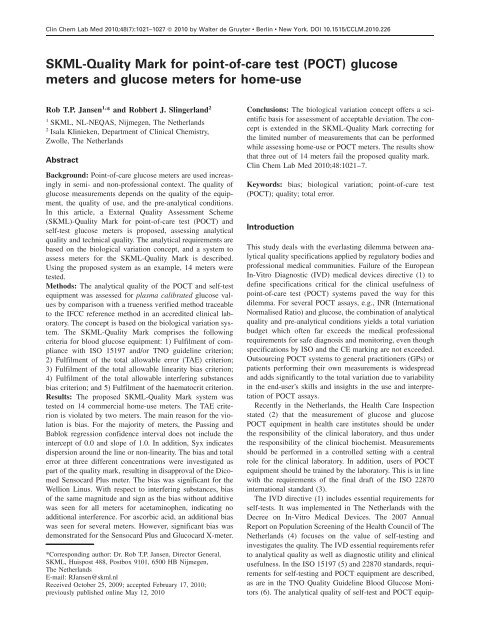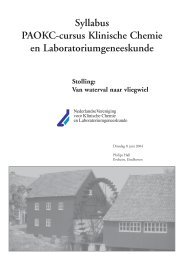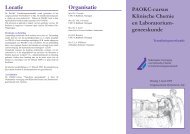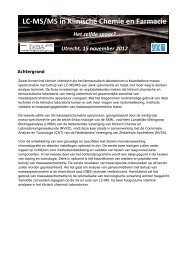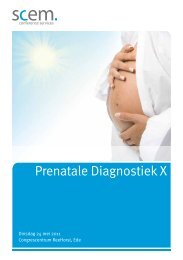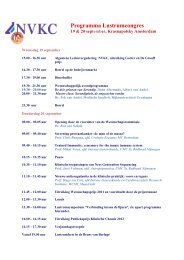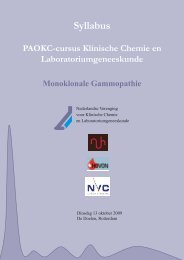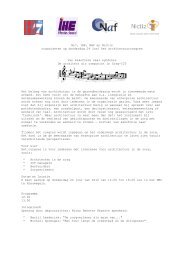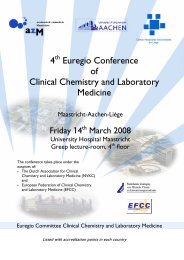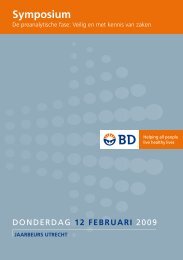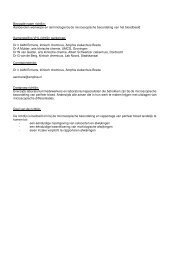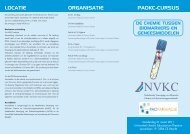SKML-Quality Mark for point-of-care test (POCT) glucose ... - NVKC
SKML-Quality Mark for point-of-care test (POCT) glucose ... - NVKC
SKML-Quality Mark for point-of-care test (POCT) glucose ... - NVKC
You also want an ePaper? Increase the reach of your titles
YUMPU automatically turns print PDFs into web optimized ePapers that Google loves.
Article in press - uncorrected pro<strong>of</strong><br />
Clin Chem Lab Med 2010;48(7):1021–1027 2010 by Walter de Gruyter • Berlin • New York. DOI 10.1515/CCLM.2010.226<br />
<strong>SKML</strong>-<strong>Quality</strong> <strong>Mark</strong> <strong>for</strong> <strong>point</strong>-<strong>of</strong>-<strong>care</strong> <strong>test</strong> (<strong>POCT</strong>) <strong>glucose</strong><br />
meters and <strong>glucose</strong> meters <strong>for</strong> home-use<br />
Rob T.P. Jansen 1, * and Robbert J. Slingerland 2<br />
1<br />
<strong>SKML</strong>, NL-NEQAS, Nijmegen, The Netherlands<br />
2<br />
Isala Klinieken, Department <strong>of</strong> Clinical Chemistry,<br />
Zwolle, The Netherlands<br />
Abstract<br />
Background: Point-<strong>of</strong>-<strong>care</strong> <strong>glucose</strong> meters are used increasingly<br />
in semi- and non-pr<strong>of</strong>essional context. The quality <strong>of</strong><br />
<strong>glucose</strong> measurements depends on the quality <strong>of</strong> the equipment,<br />
the quality <strong>of</strong> use, and the pre-analytical conditions.<br />
In this article, a External <strong>Quality</strong> Assessment Scheme<br />
(<strong>SKML</strong>)-<strong>Quality</strong> <strong>Mark</strong> <strong>for</strong> <strong>point</strong>-<strong>of</strong>-<strong>care</strong> <strong>test</strong> (<strong>POCT</strong>) and<br />
self-<strong>test</strong> <strong>glucose</strong> meters is proposed, assessing analytical<br />
quality and technical quality. The analytical requirements are<br />
based on the biological variation concept, and a system to<br />
assess meters <strong>for</strong> the <strong>SKML</strong>-<strong>Quality</strong> <strong>Mark</strong> is described.<br />
Using the proposed system as an example, 14 meters were<br />
<strong>test</strong>ed.<br />
Methods: The analytical quality <strong>of</strong> the <strong>POCT</strong> and self-<strong>test</strong><br />
equipment was assessed <strong>for</strong> plasma calibrated <strong>glucose</strong> values<br />
by comparison with a trueness verified method traceable<br />
to the IFCC reference method in an accredited clinical laboratory.<br />
The concept is based on the biological variation system.<br />
The <strong>SKML</strong>-<strong>Quality</strong> <strong>Mark</strong> comprises the following<br />
criteria <strong>for</strong> blood <strong>glucose</strong> equipment: 1) Fulfilment <strong>of</strong> compliance<br />
with ISO 15197 and/or TNO guideline criterion;<br />
2) Fulfilment <strong>of</strong> the total allowable error (TAE) criterion;<br />
3) Fulfilment <strong>of</strong> the total allowable linearity bias criterion;<br />
4) Fulfilment <strong>of</strong> the total allowable interfering substances<br />
bias criterion; and 5) Fulfilment <strong>of</strong> the haematocrit criterion.<br />
Results: The proposed <strong>SKML</strong>-<strong>Quality</strong> <strong>Mark</strong> system was<br />
<strong>test</strong>ed on 14 commercial home-use meters. The TAE criterion<br />
is violated by two meters. The main reason <strong>for</strong> the violation<br />
is bias. For the majority <strong>of</strong> meters, the Passing and<br />
Bablok regression confidence interval does not include the<br />
intercept <strong>of</strong> 0.0 and slope <strong>of</strong> 1.0. In addition, Syx indicates<br />
dispersion around the line or non-linearity. The bias and total<br />
error at three different concentrations were investigated as<br />
part <strong>of</strong> the quality mark, resulting in disapproval <strong>of</strong> the Dicomed<br />
Sensocard Plus meter. The bias was significant <strong>for</strong> the<br />
Wellion Linus. With respect to interfering substances, bias<br />
<strong>of</strong> the same magnitude and sign as the bias without additive<br />
was seen <strong>for</strong> all meters <strong>for</strong> acetaminophen, indicating no<br />
additional interference. For ascorbic acid, an additional bias<br />
was seen <strong>for</strong> several meters. However, significant bias was<br />
demonstrated <strong>for</strong> the Sensocard Plus and Glucocard X-meter.<br />
*Corresponding author: Dr. Rob T.P. Jansen, Director General,<br />
<strong>SKML</strong>, Huispost 488, Postbox 9101, 6500 HB Nijmegen,<br />
The Netherlands<br />
E-mail: RJansen@skml.nl<br />
Received October 25, 2009; accepted February 17, 2010;<br />
previously published online May 12, 2010<br />
Conclusions: The biological variation concept <strong>of</strong>fers a scientific<br />
basis <strong>for</strong> assessment <strong>of</strong> acceptable deviation. The concept<br />
is extended in the <strong>SKML</strong>-<strong>Quality</strong> <strong>Mark</strong> correcting <strong>for</strong><br />
the limited number <strong>of</strong> measurements that can be per<strong>for</strong>med<br />
while assessing home-use or <strong>POCT</strong> meters. The results show<br />
that three out <strong>of</strong> 14 meters fail the proposed quality mark.<br />
Clin Chem Lab Med 2010;48:1021–7.<br />
Keywords: bias; biological variation; <strong>point</strong>-<strong>of</strong>-<strong>care</strong> <strong>test</strong><br />
(<strong>POCT</strong>); quality; total error.<br />
Introduction<br />
This study deals with the everlasting dilemma between analytical<br />
quality specifications applied by regulatory bodies and<br />
pr<strong>of</strong>essional medical communities. Failure <strong>of</strong> the European<br />
In-Vitro Diagnostic (IVD) medical devices directive (1) to<br />
define specifications critical <strong>for</strong> the clinical usefulness <strong>of</strong><br />
<strong>point</strong>-<strong>of</strong>-<strong>care</strong> <strong>test</strong> (<strong>POCT</strong>) systems paved the way <strong>for</strong> this<br />
dilemma. For several <strong>POCT</strong> assays, e.g., INR (International<br />
Normalised Ratio) and <strong>glucose</strong>, the combination <strong>of</strong> analytical<br />
quality and pre-analytical conditions yields a total variation<br />
budget which <strong>of</strong>ten far exceeds the medical pr<strong>of</strong>essional<br />
requirements <strong>for</strong> safe diagnosis and monitoring, even though<br />
specifications by ISO and the CE marking are not exceeded.<br />
Outsourcing <strong>POCT</strong> systems to general practitioners (GPs) or<br />
patients per<strong>for</strong>ming their own measurements is widespread<br />
and adds significantly to the total variation due to variability<br />
in the end-user’s skills and insights in the use and interpretation<br />
<strong>of</strong> <strong>POCT</strong> assays.<br />
Recently in the Netherlands, the Health Care Inspection<br />
stated (2) that the measurement <strong>of</strong> <strong>glucose</strong> and <strong>glucose</strong><br />
<strong>POCT</strong> equipment in health <strong>care</strong> institutes should be under<br />
the responsibility <strong>of</strong> the clinical laboratory, and thus under<br />
the responsibility <strong>of</strong> the clinical biochemist. Measurements<br />
should be per<strong>for</strong>med in a controlled setting with a central<br />
role <strong>for</strong> the clinical laboratory. In addition, users <strong>of</strong> <strong>POCT</strong><br />
equipment should be trained by the laboratory. This is in line<br />
with the requirements <strong>of</strong> the final draft <strong>of</strong> the ISO 22870<br />
international standard (3).<br />
The IVD directive (1) includes essential requirements <strong>for</strong><br />
self-<strong>test</strong>s. It was implemented in The Netherlands with the<br />
Decree on In-Vitro Medical Devices. The 2007 Annual<br />
Report on Population Screening <strong>of</strong> the Health Council <strong>of</strong> The<br />
Netherlands (4) focuses on the value <strong>of</strong> self-<strong>test</strong>ing and<br />
investigates the quality. The IVD essential requirements refer<br />
to analytical quality as well as diagnostic utility and clinical<br />
usefulness. In the ISO 15197 (5) and 22870 standards, requirements<br />
<strong>for</strong> self-<strong>test</strong>ing and <strong>POCT</strong> equipment are described,<br />
as are in the TNO <strong>Quality</strong> Guideline Blood Glucose Monitors<br />
(6). The analytical quality <strong>of</strong> self-<strong>test</strong> and <strong>POCT</strong> equip-<br />
2010/563
Article in press - uncorrected pro<strong>of</strong><br />
1022 Jansen and Slingerland: <strong>SKML</strong>-<strong>Quality</strong> <strong>Mark</strong> <strong>for</strong> <strong>POCT</strong> <strong>glucose</strong> meters<br />
ment has been studied extensively (7–10). For medical <strong>test</strong>s<br />
in general, there is consensus about the analytical requirements<br />
in relation to diagnostic utility and clinical usefulness.<br />
These requirements are based on the biological variation concept<br />
as described by Fraser (11, 12). Data on biological variation<br />
and analytical requirements derived from this were<br />
compiled by Ricos et al. (13) and Westgard (14) in a database<br />
<strong>for</strong> a large number <strong>of</strong> clinical laboratory <strong>test</strong>s. However, neither<br />
the IVD directive or the ISO or TNO guidelines mention<br />
these requirements.<br />
In this article, a (External <strong>Quality</strong> Assessment Scheme)<br />
<strong>SKML</strong>-<strong>Quality</strong> <strong>Mark</strong> <strong>for</strong> <strong>POCT</strong> and self-<strong>test</strong> <strong>glucose</strong> meters<br />
is proposed, assessing analytical quality and technical quality.<br />
The analytical requirements are based on the biological<br />
variation concept, and a system to assess meters <strong>for</strong> the<br />
<strong>SKML</strong>-<strong>Quality</strong> <strong>Mark</strong> is described. Using the proposed system<br />
as an example, 14 meters were <strong>test</strong>ed.<br />
Materials and methods<br />
The quality <strong>of</strong> a <strong>glucose</strong> measurement using a <strong>POCT</strong> or self-<strong>test</strong><br />
meter depends on the quality <strong>of</strong> the equipment, the quality <strong>of</strong> how<br />
it is used, and the pre-analytical conditions. The <strong>SKML</strong>-<strong>Quality</strong><br />
<strong>Mark</strong> assesses the quality <strong>of</strong> the equipment on two aspects: analytical<br />
quality based on the biological variation concept, and technical<br />
quality based on the ISO 15197 and the TNO guideline.<br />
Analytical quality<br />
To assess the analytical quality <strong>of</strong> the equipment in relation to the<br />
diagnostic utility and clinical usefulness, the analytical goal is based<br />
on the biological variation concept. The analytical quality <strong>of</strong> the<br />
<strong>POCT</strong> and self-<strong>test</strong> equipment is assessed using plasma calibrated<br />
<strong>glucose</strong> values compared with a trueness verified method traceable<br />
to the IFCC reference method in an accredited clinical laboratory.<br />
In this investigation, the hexokinase method using the Roche Integra<br />
(Nederland BV, Almere, The Netherlands) with plasma obtained<br />
from centrifuged heparinized whole blood was used. To correct <strong>for</strong><br />
any bias in the hexokinase method on a specific day <strong>of</strong> <strong>test</strong>ing,<br />
commutable and IFCC reference method targeted <strong>SKML</strong> Calibration<br />
2000 samples (15, 16) were also measured. During the study period,<br />
no bias from the reference materials was observed.<br />
The analytical quality <strong>of</strong> 14 different types <strong>of</strong> meters was <strong>test</strong>ed<br />
type by type. Five meters <strong>of</strong> each type were evaluated.<br />
To assess the quality <strong>of</strong> one type <strong>of</strong> <strong>glucose</strong> <strong>POCT</strong> or home-use<br />
meter, three 6 mL heparinized venous blood samples (without separator<br />
gel) were obtained from an apparently healthy person, who<br />
was not taking any medication. An aliquot <strong>of</strong> 0.5 mL was removed<br />
through the cap <strong>of</strong> a tube, centrifuged and analysed <strong>for</strong> <strong>glucose</strong><br />
using the comparison method. Using a needle, an aliquot (1 mL <strong>for</strong><br />
6 and <strong>of</strong> 2 mL <strong>for</strong> 10 mmol/L) <strong>of</strong> a 45% <strong>glucose</strong> solution in water<br />
was added through the caps <strong>of</strong> two <strong>of</strong> the tubes to produce <strong>glucose</strong><br />
concentrations <strong>of</strong> approximately 6 mmol/L and 10 mmol/L, respectively.<br />
The third tube was maintained until the <strong>glucose</strong> concentration<br />
was about 3 mmol/L. Aliquots <strong>of</strong> 0.5 mL were removed though the<br />
caps <strong>of</strong> the three tubes, centrifuged and analysed <strong>for</strong> <strong>glucose</strong> using<br />
the comparison method 10 times each. Immediately following the<br />
completion <strong>of</strong> centrifugation, measurements using the comparison<br />
method and the <strong>glucose</strong> meters were started. The measurements<br />
were per<strong>for</strong>med within 120 s <strong>for</strong> the 25 measurements at each concentration,<br />
and within 240 s <strong>for</strong> the 50 measurements <strong>for</strong> estimation<br />
<strong>of</strong> imprecision. In addition, pO 2 was measured in the three tubes<br />
<strong>for</strong> meters using the <strong>glucose</strong> oxidase method. For <strong>glucose</strong> meters<br />
using this method, the partial pressure <strong>of</strong> oxygen in the sample is<br />
required that is comparable to the pO 2 in capillary blood. There<strong>for</strong>e,<br />
tubes were mixed prior to the procedures until the pO 2 was within<br />
8.0 and 12.0 kPa. Whole blood <strong>glucose</strong> measurements were per<strong>for</strong>med<br />
by sampling blood through the caps <strong>of</strong> the tubes and applied<br />
to the five meters we investigated that used this method in each<br />
session.<br />
The imprecision <strong>of</strong> the handheld equipment was estimated at a<br />
<strong>glucose</strong> concentration <strong>of</strong> 6 mmol/L using 50 measurements, 10 on<br />
each <strong>of</strong> the five meters that were <strong>test</strong>ed per type <strong>of</strong> meter (total 50<br />
measurements per type <strong>of</strong> meter) using two different lots <strong>of</strong> <strong>test</strong><br />
strips. The bias <strong>of</strong> the handheld equipment was estimated from 75<br />
measurements, five measurements at each <strong>of</strong> three concentrations,<br />
on each <strong>of</strong> the five meters. Total error was also estimated from the<br />
basis <strong>of</strong> the combined 75 measurements.<br />
Linearity was assessed using three concentrations <strong>of</strong> 3, 6 and<br />
10 mmol/L, according to the Passing and Bablok regression.<br />
Interference from acetaminophen was assessed by splitting freshly<br />
drawn heparinized venous blood into two 1 mL aliquots, adding<br />
1 mL <strong>of</strong> a concentrated solution (66 mmol/L) <strong>of</strong> the substance to a<br />
final concentration <strong>of</strong> 66 mmol/L, and the same amount <strong>of</strong> saline<br />
(154 mmol/L) to the second aliquot. Glucose was measured in each<br />
<strong>of</strong> the aliquots using five meters. From each <strong>of</strong> the aliquots, 0.5 mL<br />
was centrifuged and plasma <strong>glucose</strong> was measured five times using<br />
the trueness-verified Roche Integra hexokinase method.<br />
Interference from ascorbic acid was assessed in essentially the<br />
same way (using a concentrated solution <strong>of</strong> 170 mmol/L ascorbic<br />
acid) at a final concentration <strong>of</strong> 170 mmol/L.<br />
The effect <strong>of</strong> haematocrit was assessed by measuring the haematocrit<br />
in three heparinized venous blood samples having <strong>glucose</strong><br />
concentrations <strong>of</strong> approximately 3, 6 and 10 mmol/L. Each sample<br />
was centrifuged, and <strong>for</strong> each <strong>glucose</strong> concentration, four portions<br />
were prepared with haematocrit values <strong>of</strong> approximately 0.25, 0.35,<br />
0.45 and 0.55. The haematocrit was measured using a Sysmex 2500<br />
analyzer (Sysmex Nederland BV, Etten-Leur, The Netherlands).<br />
Glucose in each portion (with the pO 2 between 8.0 and 12.0 kPa)<br />
was measured in duplicate on two meters and in the plasma obtained<br />
after centrifugation using the hexokinase method.<br />
Statistical methods<br />
We used the known within- and between-person variation. For <strong>glucose</strong>,<br />
the within-person variation, CVw, is 5.7% and the betweenperson<br />
variation, CVb, is 6.9%. From these the allowable bias (AB)<br />
is calculated as<br />
2 2<br />
ABs0.25=6(CVw qCVb )s2.23%.<br />
The desirable analytical variation<br />
CVds0.5=CVws2.9%<br />
and the total allowable error (TAE)<br />
TAEsABq(1.65=CVd)s7.0%.<br />
However, with these calculations a definitive known target value<br />
is assumed. In the present study, there is an uncertainty component<br />
in the estimation <strong>of</strong> the target value. This uncertainty is accounted<br />
<strong>for</strong> under the next section ‘uncertainty in target value <strong>of</strong> the trueness<br />
verified method’.
Article in press - uncorrected pro<strong>of</strong><br />
Jansen and Slingerland: <strong>SKML</strong>-<strong>Quality</strong> <strong>Mark</strong> <strong>for</strong> <strong>POCT</strong> <strong>glucose</strong> meters 1023<br />
Uncertainty in target value <strong>of</strong> the trueness verified method<br />
The target values m and standard deviation (SD) s <strong>of</strong> the trueness<br />
verified method are estimated from a limited set <strong>of</strong> measurements,<br />
introducing additional uncertainty depending on the number <strong>of</strong><br />
measurements. The target value is estimated from 10 measurements<br />
at each <strong>of</strong> three levels. The imprecision <strong>of</strong> the hexokinase method<br />
was CVts1.6%. The confidence interval (CI) <strong>for</strong> m (P 95%) is<br />
X–1.96=CVt/630FmFXq1.96=CVt/630<br />
or<br />
X–0.57%FmFXq0.57%.<br />
At each individual level the uncertainty is (P 99%):<br />
X–2.58=CVt/610FmFXq2.58=CVt/610<br />
or<br />
X–1.31%FmFXq1.31%.<br />
Uncertainty <strong>of</strong> bias The bias <strong>of</strong> the <strong>POCT</strong> meters was estimated<br />
on the basis <strong>of</strong> 15 measurements on each <strong>of</strong> five meters, i.e., 75<br />
measurements. The CI (P 95%) <strong>of</strong> the true mean m m at a CVd <strong>of</strong><br />
2.9% is<br />
Y–1.96=CVd/675Fm FYq1.96CVd/675<br />
m<br />
where Y is the mean <strong>of</strong> the 75 measurements. Then<br />
Y–0.65%Fm FYq0.65%.<br />
m<br />
Thus, on the basis <strong>of</strong> 75 measurements and including an uncertainty<br />
in the target value <strong>of</strong> 0.57%, the AB<br />
AB<br />
max<br />
sABqconf(ref)qconf(Y)s2.23%q0.57%q0.65%s3.5%<br />
(first column <strong>of</strong> Table 2A and B).<br />
At each individual level (25 measurements, P 99%)<br />
ABmaxs2.23%q2.58=CVt/610q2.58=CVd/625<br />
s2.23%q1.31%q1.50%s5.0%<br />
(right part <strong>of</strong> Table 2A describing the AB at a low, middle and high<br />
concentration <strong>of</strong> <strong>glucose</strong> determined with 25 measurements at each<br />
level).<br />
Uncertainty <strong>of</strong> imprecision The imprecision sm <strong>of</strong> the meter<br />
was estimated from 50 measurements, 10 in each <strong>of</strong> five meters at<br />
a concentration <strong>of</strong> 6 mmol/L. The CI (P 95%) <strong>of</strong> sm is<br />
2 2<br />
6(n–1)CVd /aFsmF6(n–1)CVd /b<br />
where as31.6 and bs70.2 from the x 2 -table at 49 degrees <strong>of</strong> freedom.<br />
Then, <strong>for</strong> CVds2.9%, the CI <strong>for</strong> sm is 2.4%FsmF3.6%.<br />
Thus, on the basis <strong>of</strong> 50 measurements, the upper limit <strong>for</strong> the<br />
imprecision was CVd max s3.6% (Table 2A).<br />
A second measure <strong>of</strong> imprecision is the residual SD <strong>of</strong> regression,<br />
Syx, calculated in the linear regression (see Linearity).<br />
Uncertainty in total error The total error was estimated from 75<br />
measurements. The CIs <strong>of</strong> bias and imprecision resulted in a TAE<br />
(P 95%) <strong>of</strong>:<br />
TAEsABmaxq(1.65=CVd max)s3.45%q1.65=3.6%s9.4%<br />
(left side <strong>of</strong> Table 2A).<br />
At each individual level and using the Syx from the linear regression<br />
as estimate <strong>for</strong> imprecision TAE (P 99%) was<br />
TAEs5.0%q2.33=3.6%s13.4%<br />
(right side <strong>of</strong> Table 2A).<br />
Linearity Linearity <strong>of</strong> the blood <strong>glucose</strong> meters was assessed<br />
using three sets <strong>of</strong> five samples each at <strong>glucose</strong> concentrations <strong>of</strong><br />
3, 6 and 10 mmol/L. Samples were analysed on five meters, and in<br />
replicates <strong>of</strong> five with the hexokinase method. Using the method <strong>of</strong><br />
Passing and Bablok, the line YsaqbX was calculated, including<br />
the CIs (P 95%) <strong>for</strong> the intercept and slope. If the confidence limits<br />
<strong>of</strong> intercept and slope did not include 0.0 and 1.0, respectively, the<br />
bias at individual levels was inspected.<br />
A measure <strong>of</strong> imprecision is the residual variance Syx. A large<br />
Syx indicates large dispersion around the line, or non-linearity.<br />
Since linearity was estimated from measurements at three concentrations,<br />
the CI <strong>of</strong> Syx was estimated at P 99%. The CI <strong>for</strong> Syx was<br />
2 2<br />
6(n–1)CVd /aFSyxF6(n–1)CVd /b<br />
where as47.9 and bs104.0 from the x 2 -table at ny2s73 degrees<br />
<strong>of</strong> freedom. Then, <strong>for</strong> CVds2.9%, the CI <strong>for</strong> Syx is 2.4%F<br />
SyxF3.6%. This allowable Syx (ASyx) <strong>of</strong> 3.6% was used (Table<br />
2A). Syx was used in the estimation <strong>of</strong> TAE at individual concentrations.<br />
The total error at individual concentrations was estimated<br />
from the bias at that concentration and the CV as estimated from<br />
the 50 measurements.<br />
If intercept or slope exceeded the limit, the bias at each individual<br />
concentration was compared with AB max at that concentration, and<br />
if these exceed the total error at each concentration they were compared<br />
with the TAE at that concentration level.<br />
Interfering substances The interference from different substances<br />
was <strong>test</strong>ed at therapeutic levels (<strong>for</strong> each substance five<br />
measurements at five meters). Acetaminophen and ascorbic acid<br />
were <strong>test</strong>ed at final concentrations <strong>of</strong> 66 mmol/L (10 mg/L) and<br />
170 mmol/L (30 mg/L), respectively. The maximum AB (P 99%)<br />
AB max was<br />
ABmaxsABq2.58=CVt/65q2.58=CVd/65<br />
s2.23%q1.85%q3.35%s7.4%<br />
(Table 2B).<br />
At a CVd max <strong>of</strong> 3.6%, the TAE <strong>for</strong> interfering substances (P 99%)<br />
was<br />
TAEsABmaxq2.33=CVdmaxs5.9%q2.33=3.6s14.3%<br />
(Table 2B).<br />
Technical quality<br />
Prior to measurements, handheld blood <strong>glucose</strong> meters should, at a<br />
minimum, comply with the ISO 15197 standard and/or the TNO<br />
guideline. These documents include, in addition to aspects <strong>of</strong> safety,
Article in press - uncorrected pro<strong>of</strong><br />
1024 Jansen and Slingerland: <strong>SKML</strong>-<strong>Quality</strong> <strong>Mark</strong> <strong>for</strong> <strong>POCT</strong> <strong>glucose</strong> meters<br />
analytical requirements. The most important aspect in the TNO<br />
guideline is that it allows a 15% deviation in <strong>glucose</strong> values<br />
obtained with a handheld meter vs. the hexokinase method, and ISO<br />
15197 allows <strong>for</strong> a 20% deviation vs. the reference method (type to<br />
be chosen by the manufacturer).<br />
<strong>SKML</strong>-<strong>Quality</strong> <strong>Mark</strong><br />
The <strong>SKML</strong>-<strong>Quality</strong> <strong>Mark</strong> comprises the following criteria <strong>for</strong> blood<br />
<strong>glucose</strong> equipment:<br />
1. Fulfilment <strong>of</strong> compliance with ISO 15197 and/or TNO guideline<br />
criterion.<br />
2. Fulfilment <strong>of</strong> the TAE criterion.<br />
3. Fulfilment <strong>of</strong> the total allowable linearity bias criterion.<br />
4. Fulfilment <strong>of</strong> the total allowable interfering substances bias<br />
criterion.<br />
5. Fulfilment <strong>of</strong> the haematocrit criterion.<br />
If a meter failed one <strong>of</strong> the criteria, the data were inspected <strong>for</strong><br />
possible outliers that influenced the results using Box and Whisker<br />
plots. If an outlier was detected, it was removed and the results<br />
recalculated.<br />
A <strong>SKML</strong>-<strong>Quality</strong> <strong>Mark</strong> approved meter should be used by appropriately<br />
trained personnel or patients.<br />
Comparison <strong>of</strong> user-meters with the laboratory<br />
The quality <strong>of</strong> the analysis should be checked regularly using control<br />
materials <strong>for</strong> <strong>POCT</strong> equipment, and at least once a year <strong>for</strong><br />
home-use meters by comparison <strong>of</strong> a measurement by the user with<br />
the laboratory method. Assessment <strong>of</strong> a measurement on a homeuse<br />
blood <strong>glucose</strong> meter was done as follows. The patient per<strong>for</strong>med<br />
a measurement in the same manner he/she normally per<strong>for</strong>ms measurements,<br />
in duplicate. At the same time, heparin blood was collected<br />
from the patient <strong>for</strong> plasma <strong>glucose</strong>. The plasma <strong>glucose</strong> was<br />
also measured in duplicate.<br />
Results<br />
The proposed <strong>SKML</strong>-<strong>Quality</strong> <strong>Mark</strong> system was <strong>test</strong>ed as an<br />
example on 14 commercial home-use meters (Table 1). The<br />
blood <strong>glucose</strong> meters were <strong>test</strong>ed according to the procedure<br />
described in Methods. The first <strong>SKML</strong> benchmark criterion<br />
is in compliance with ISO 15197 or the TNO guideline. All<br />
14 meters fulfilled this criterion. All calculated <strong>SKML</strong>-<strong>Quality</strong><br />
<strong>Mark</strong> parameters are shown in Table 2A and B. For example,<br />
the results <strong>for</strong> the Abbot freedom lite meter (second row<br />
in Table 2A and B) included a bias <strong>of</strong> –4.2% (mean value<br />
<strong>of</strong> 75 measurements <strong>of</strong> 7.493 mmol/L vs. a hexokinase mean<br />
<strong>of</strong> 7.733 mmol/L); CV <strong>of</strong> 2.9% resulting from 10 measurements<br />
on each <strong>of</strong> five meters using the same sample with a<br />
concentration <strong>of</strong> approximately 6 mmol/L; bias and CV combine<br />
<strong>for</strong> a TE <strong>of</strong> 4.2q1.65 (2.9)s8.9%; bias at a concentration<br />
<strong>of</strong> 5 mmol/L was –7.1% (mean value <strong>of</strong> 25<br />
measurements <strong>of</strong> 4.720 mmol/L vs. a hexokinase mean <strong>of</strong><br />
5.080 mmol/L; bias <strong>of</strong> –5.3% at a concentration <strong>of</strong><br />
6.5 mmol/L (mean <strong>of</strong> 6.196 vs. 6.540); bias <strong>of</strong> –0.1% at a<br />
concentration <strong>of</strong> 11.5 mmol/L (mean <strong>of</strong> 11.564 vs. 11.580);<br />
TE <strong>of</strong> –11.9 at a concentration <strong>of</strong> 5 mmol/L resulting from<br />
a bias <strong>of</strong> –7.1% and 1.65 times the CV <strong>of</strong> 2.9%; TE <strong>of</strong><br />
–10.0% at 6.5 mmol/L resulting from the bias <strong>of</strong> –5.3% and<br />
the CV <strong>of</strong> 2.9%; TE <strong>of</strong> –4.9% at 11.5 mmol/L resulting from<br />
a bias <strong>of</strong> –0.1% and a CV <strong>of</strong> 2.9%; Table 2B: bias <strong>of</strong> –4.2%<br />
if no additive wequal to first bias column in Table 2A; acetaminophen<br />
concentration <strong>of</strong> 10 mg/L, bias <strong>of</strong> –1.3% (mean<br />
<strong>of</strong> one measurement in each <strong>of</strong> five meters <strong>of</strong> 5.980 vs. hexokinase<br />
mean <strong>of</strong> 6.060); ascorbic acid concentration <strong>of</strong> 30 mg/L,<br />
bias <strong>of</strong> –2.8% (mean <strong>of</strong> 4.240 vs. hexokinase mean <strong>of</strong><br />
4.460)x. Table 2A shows that the total error <strong>for</strong> the Wellion<br />
Linus was 16.2%, and <strong>for</strong> Glucocard X-meter was 13.4%,<br />
both larger that the TAE <strong>of</strong> 9.4%. Total error at individual<br />
levels (Table 2A) were –30.2% <strong>for</strong> Wellion Linus and<br />
–18.1% <strong>for</strong> Glucocard X-meter at the low level. Total error<br />
as 13.9% <strong>for</strong> Sensocard plus at the middle level and –13.6%<br />
<strong>for</strong> Glucocard X-meter at the high level. The presence <strong>of</strong><br />
acetaminophen resulted in bias <strong>of</strong> –12.9% <strong>for</strong> Wellion Linus<br />
(Table 2B). The presence <strong>of</strong> ascorbic acid resulted in a bias<br />
<strong>of</strong> 11.9% <strong>for</strong> Sensocard plus and 8.7% <strong>for</strong> the Glucocard X-<br />
meter. Table 3 summarizes the five <strong>SKML</strong> benchmark criteria<br />
<strong>for</strong> the 14 meters. Figure 1 shows the results <strong>of</strong> the<br />
second benchmark criterion.<br />
Discussion<br />
The quality <strong>of</strong> analytical processes has been a major topic in<br />
laboratory medicine <strong>for</strong> many years. Internal and external<br />
quality assessment makes good sense. The introduction <strong>of</strong><br />
total quality systems and accreditation has enhanced the<br />
quality <strong>of</strong> medical laboratories, including the pre- and postanalytical<br />
aspects. Since the introduction <strong>of</strong> <strong>POCT</strong>s, the<br />
necessity <strong>for</strong> quality assessment <strong>of</strong> such measurements has<br />
become increasingly clear (17). International and national<br />
guidelines and regulations put the responsibility <strong>for</strong> the per<strong>for</strong>mance<br />
<strong>of</strong> the <strong>POCT</strong> in the hands <strong>of</strong> the medical labora-<br />
Table 1 Blood <strong>glucose</strong> meters, company, type and <strong>test</strong> principle,<br />
<strong>test</strong>ed <strong>for</strong> the <strong>SKML</strong>-<strong>Quality</strong> mark.<br />
Company Type Test principle<br />
Abbott Freestyle freedom Dehydrogenase<br />
Abbott Freestyle freedom lite Dehydrogenase<br />
Abbott Freestyle lite Dehydrogenase<br />
Abbott Freestyle mini Dehydrogenase<br />
Abbott Precision X-ceed Dehydrogenase<br />
Bayer Contour Oxidase<br />
Boeren Wellion Linus Oxidase<br />
Dicomed Sensocard plus Oxidase<br />
Lifescan One touch ultra 2 Oxidase<br />
Lifescan One touch ultra easy Oxidase<br />
Lifescan One touch vita Oxidase<br />
Menarini Glucocard X-meter Dehydrogenase<br />
Roche Accuchek aviva Dehydrogenase<br />
Roche Accuchek compact plus Dehydrogenase<br />
Abbott BV, Amersfoort, The Netherlands; Bayer BV, Mijdrecht,<br />
The Netherlands; Boeren Medical BV, Tilburg, The Netherlands;<br />
Dicomed BV, Zwolle, The Netherlands; Lifescan Benelux, Tilburg,<br />
The Netherlands; A. Menarini Diagnostics Benelux NV, Valkenswaard,<br />
The Netherlands; Roche Diagnostics Nederland BV,<br />
Almere, The Netherlands.
Article in press - uncorrected pro<strong>of</strong><br />
Jansen and Slingerland: <strong>SKML</strong>-<strong>Quality</strong> <strong>Mark</strong> <strong>for</strong> <strong>POCT</strong> <strong>glucose</strong> meters 1025<br />
Table 2A Proposed <strong>SKML</strong>-<strong>Quality</strong> <strong>Mark</strong> results <strong>for</strong> 14 <strong>POCT</strong>/home-use meters (part 1).<br />
<strong>SKML</strong>-QM AB max % CVd max % TAE% ASyx% AB max % 5.0 TAE% 13.4<br />
3.6<br />
3.5 3.6 9.4<br />
Bias% TE%<br />
Company Type Bias% CV% TE% Ysaqbx Conf (a) Conf (b) Low Middle High Low Middle High<br />
Abbott Freestyle freedom A 0.0 3.1 5.1 Ys–0.12q1.04X –0.47 to 0.15 0.95–1.12 –1.5 6.5 –4.9 –6.7 11.6 –10.0<br />
Abbott Freestyle freedom lite B –4.2 2.9 8.9 Ys–0.97q1.10X –1.55 to –0.68 1.05–1.18 –7.1 –5.3 –0.1 –11.9 –10.0 –4.9<br />
Abbott Freestyle lite C –1.4 4.7 9.1 Ys–0.84q1.09X –1.35 to –0.42 1.03–1.18 –3.2 0.7 –1.7 –11.0 8.5 –9.4<br />
Abbott Freestyle mini D 3.4 2.2 7.1 Ys–0.19q1.06X –0.28 to –0.02 1.04–1.09 2.5 4.6 2.3 6.1 8.3 6.0<br />
Abbott Precision X-ceed E –0.5 4.9 8.6 Ys–0.50q1.10X –0.80 to –0.28 1.05–1.16 –5.3 4.7 –1.0 –13.4 12.8 –9.1<br />
Bayer Contour F –0.2 3.2 5.4 Ys0.06q0.98X –0.00 to 0.20 0.96–1.00 1.6 0.3 –2.4 6.9 5.6 –7.7<br />
Boeren Wellion Linus G –10.3 3.6 16.2 Ys–1.72q1.17X –2.03 to –1.60 1.14–1.22 –24.3 –5.8 –0.7 –30.2 –11.7 –6.6<br />
Dicomed Sensocard plus H 0.9 3.8 7.2 Ys–0.38q1.09X –0.88 to 0.16 0.99–1.21 1.4 7.6 –6.3 7.7 13.9 –12.5<br />
Lifescan One touch ultra 2 I 0.6 2.3 4.4 Ys–0.53q1.10X –1.13 to –0.19 1.06–1.17 4.1 –6.4 4.0 7.9 –10.2 7.8<br />
Lifescan One touch ultra easy J –4.8 2.1 8.2 Ys0.07q0.93X –0.14 to 0.14 0.92–0.96 –2.9 –4.9 –6.4 –6.4 –8.4 –9.9<br />
Lifescan One touch vita K –3.2 3.6 9.1 Ys0.09q0.95X 0.03 to 0.28 0.93–0.96 –1.4 –2.4 –5.7 –7.3 –8.3 –11.7<br />
Menarini Glucocard X-meter L –9.2 2.6 13.4 Ys–0.50q1.00X –0.88 to –0.23 0.95–1.08 –13.8 –4.4 –9.3 –18.1 –8.7 –13.6<br />
Roche Accuchek aviva M 1.6 1.9 4.8 Ys–0.11q1.03X –0.31 to 0.04 1.02–1.06 5.1 –2.2 2.0 8.2 –5.3 5.2<br />
Roche Accuchek compact plus N –0.1 1.8 3.0 Ys–0.00q1.00X –0.10 to 0.15 0.98–1.02 2.8 –2.6 0.1 5.7 –5.6 3.1<br />
Roche Integra O 0.0 1.6 2.6<br />
CV% in italics: one outlier removed. Bold printed: violation <strong>of</strong> TAE criterion.<br />
tory. The market <strong>for</strong> <strong>POCT</strong> and self-<strong>test</strong> equipment is large,<br />
and the number <strong>of</strong> <strong>test</strong>s and equipment that appear on the<br />
market is increasing markedly. It is the responsibility <strong>of</strong> the<br />
pr<strong>of</strong>ession <strong>of</strong> clinical chemistry and laboratory medicine to<br />
assess the quality <strong>of</strong> these <strong>test</strong>s (18). The <strong>SKML</strong>-<strong>Quality</strong><br />
<strong>Mark</strong> <strong>for</strong> <strong>POCT</strong> and self-<strong>test</strong> blood <strong>glucose</strong> meters presented<br />
in this paper should facilitate this.<br />
<strong>SKML</strong>-<strong>Quality</strong> <strong>Mark</strong><br />
The <strong>SKML</strong>-<strong>Quality</strong> <strong>Mark</strong> is based on the analytical requirements<br />
<strong>for</strong> measurement as defined by the biological variation<br />
concept. The rationale <strong>of</strong> this concept is that in clinical<br />
diagnosis and monitoring, analytical random variation must<br />
be kept so low that numerical changes in <strong>test</strong> results in an<br />
individual do reflect changes in that person, and not analytical<br />
noise. The concept is widely accepted in the field <strong>of</strong><br />
clinical chemistry and laboratory medicine. The <strong>Quality</strong><br />
<strong>Mark</strong> is used to <strong>test</strong> meters. However, an approved meter<br />
does not guarantee a good measurement. Inappropriate use,<br />
deterioration, incorrect preservation <strong>of</strong> strips and other preanalytical<br />
errors may lead to incorrect measurements (19). A<br />
serious example is given below. There<strong>for</strong>e, regular supervision<br />
by an accredited medical laboratory is essential to guarantee<br />
adequate results.<br />
The selected meters were the most frequently used meters<br />
by patients in the diabetes policlinic <strong>of</strong> the hospital <strong>of</strong> one<br />
<strong>of</strong> the authors.<br />
In the present ISO 15197 standard, a deviation <strong>of</strong> 20%<br />
from the target value is accepted. However, the 20% deviation<br />
was based on what was technically possible at the time<br />
the ISO standard was agreed upon. Previous studies (9) have<br />
suggested that a TAE <strong>of</strong> 15% presents a risk <strong>for</strong> diabetics to<br />
incorrectly dose insulin. Whatever TAE criterion is suggested<br />
by medical pr<strong>of</strong>essionals in this study or other studies, it is<br />
always much more restricted than the ISO specifications<br />
referred to by manufacturers and sets the stage <strong>for</strong> everyday<br />
analytical quality <strong>of</strong> <strong>glucose</strong> <strong>POCT</strong> systems in the marketplace.<br />
The struggle <strong>for</strong> improvement carries on, supported<br />
by this study that provides a clinically relevant model <strong>for</strong><br />
benchmarking <strong>of</strong> <strong>glucose</strong> <strong>POCT</strong> systems. The biological variation<br />
concept <strong>of</strong>fers a sound scientific basis <strong>for</strong> assessment<br />
<strong>of</strong> medically acceptable deviation. The concept is extended<br />
in the <strong>SKML</strong>-<strong>Quality</strong> <strong>Mark</strong> correcting <strong>for</strong> the limited number<br />
<strong>of</strong> measurements that can be done while assessing home-use<br />
or <strong>POCT</strong> meters. The results show that three out <strong>of</strong> 14 meters<br />
fail the proposed quality mark.<br />
Results <strong>for</strong> 14 meters (Table 3)<br />
The TAE criterion was violated by two meters (Wellion<br />
Linus and Glucocard X-meters). The main reason <strong>for</strong> the<br />
violation is bias. For the majority <strong>of</strong> meters, Passing and<br />
Bablok regression CI does not include the intercept <strong>of</strong> 0.0<br />
and slope <strong>of</strong> 1.0. The bias and total error at three different<br />
levels was inspected as part <strong>of</strong> the quality mark. This resulted<br />
in disapproval <strong>of</strong> the Wellion Linus, Dicomed Sensocard<br />
Plus, and Glucocard X-meters. A significant bias was<br />
observed in the presence <strong>of</strong> acetaminophen <strong>for</strong> Wellion
Article in press - uncorrected pro<strong>of</strong><br />
1026 Jansen and Slingerland: <strong>SKML</strong>-<strong>Quality</strong> <strong>Mark</strong> <strong>for</strong> <strong>POCT</strong> <strong>glucose</strong> meters<br />
Table 2B Proposed <strong>SKML</strong>-<strong>Quality</strong> <strong>Mark</strong> results <strong>for</strong> 14 <strong>POCT</strong>/home-use meters (part 2).<br />
<strong>SKML</strong>-QM No additive Acetaminophen Ascorbic acid<br />
66 mmol/L 170 mmol/L<br />
AB max 3.5% AB max 7.4% AB max 7.4%<br />
Company Type Bias% Bias% Bias%<br />
Abbott Freestyle freedom 0.0 –3.6 –6.8<br />
Abbott Freestyle freedom lite –4.2 –1.3 –2.8<br />
Abbott Freestyle lite –1.4 –1.7 6.4<br />
Abbott Freestyle mini 3.4 –1.3 –5.7<br />
Abbott Precision X-ceed –0.5 –2.8 5.7<br />
Bayer Contour –0.2 –5.9 –4.1<br />
Boeren Wellion Linus –10.3 –12.9 6.4<br />
Dicomed Sensocard plus 0.9 3.6 11.9<br />
Lifescan One touch ultra 2 0.6 –2.6 –6.4<br />
Lifescan One touch ultra easy –4.8 –2.0 –6.0<br />
Lifescan One touch vita –3.2 –0.3 NM<br />
Menarini Glucocard X-meter –9.2 0.8 8.7<br />
Roche Accuchek aviva 1.6 –5.1 3.2<br />
Roche Accuchek compact plus –0.1 –6.7 4.1<br />
Bold printed: violation <strong>of</strong> interfering substances bias criterion.<br />
Linus. Ascorbic acid caused an additional bias <strong>for</strong> the Sensocard<br />
Plus and Glucocard X-meters.<br />
All measurements were per<strong>for</strong>med in samples having haematocrits<br />
within the specifications <strong>of</strong> the manufacturer. The<br />
measurements at four haematocrit levels revealed no additional<br />
deviation (data not shown).<br />
<strong>SKML</strong>-<strong>Quality</strong> <strong>Mark</strong> in practice<br />
Meters that complied with the <strong>SKML</strong>-<strong>Quality</strong> <strong>Mark</strong> were<br />
recommended to nurse practitioners and patients. Approved<br />
meters were the Abbot freestyle freedom, freestyle freedom<br />
lite, freestyle lite, freestyle mini and precision X-ceed; Bayer<br />
Contour; Lifescan one touch ultra, one touch ultra easy and<br />
one touch vita; Roche Accuchek aviva, Accuchek compact<br />
plus. Disapproved meters were Boeren Wellion Linus; Dicomed<br />
Sensocard plus; Menarini glucocard X-meter. An<br />
approved meter does not guarantee good measurement. Users<br />
were trained to per<strong>for</strong>m measurements and their per<strong>for</strong>mance<br />
was assessed on a regular basis. To show that such a system<br />
is essential and there<strong>for</strong>e part <strong>of</strong> the <strong>SKML</strong>-<strong>Quality</strong> <strong>Mark</strong>,<br />
we briefly discuss an example <strong>for</strong> measurements per<strong>for</strong>med<br />
by one patient. This patient used an approved meter. At his<br />
biannual assessment, the patient measured a <strong>glucose</strong> value<br />
<strong>of</strong> 10 mmol/L using his own meter. The result from the laboratory<br />
<strong>for</strong> a plasma sample was 5 mmol/L. The patient was<br />
asked to send in his meter. Assessment revealed that the<br />
meter showed a structural positive bias <strong>of</strong> 50%, caused by<br />
an unknown factor. The patient was on insulin and frequently<br />
had hypoglycaemia because <strong>of</strong> overdosing insulin. Thus, <strong>for</strong><br />
Table 3<br />
Results <strong>for</strong> 14 <strong>POCT</strong>/home-use meters as <strong>test</strong>ed with the proposed <strong>SKML</strong>-<strong>Quality</strong> <strong>Mark</strong> benchmark criteria.<br />
<strong>SKML</strong>-QM ISO 15197 TAE% TAE% AB Haematocrit<br />
or TNO linearity interference<br />
Company Type 9.4% 13.4% 7.4% 0.25–0.55<br />
Abbott Freestyle freedom A OK OK OK OK OK<br />
Abbott Freestyle freedom lite B OK OK OK OK OK<br />
Abbott Freestyle lite C OK OK OK OK OK<br />
Abbott Freestyle mini D OK OK OK OK OK<br />
Abbott Precision X-ceed E OK OK OK OK OK<br />
Bayer Contour F OK OK OK OK OK<br />
Boeren Wellion Linus G OK Failed Failed Failed OK<br />
Dicomed Sensocard plus H OK OK Failed Failed OK<br />
Lifescan One touch ultra 2 I OK OK OK OK OK<br />
Lifescan One touch ultra easy J OK OK OK OK OK<br />
Lifescan One touch vita K OK OK OK OK OK<br />
Menarini Glucocard X-meter L OK Failed Failed Failed OK<br />
Roche Accuchek aviva M OK OK OK OK OK<br />
Roche Accuchek compact plus N OK OK 5.7 OK OK<br />
Bold printed: violation <strong>of</strong> criterion.
Article in press - uncorrected pro<strong>of</strong><br />
Jansen and Slingerland: <strong>SKML</strong>-<strong>Quality</strong> <strong>Mark</strong> <strong>for</strong> <strong>POCT</strong> <strong>glucose</strong> meters 1027<br />
Figure 1 Total error <strong>of</strong> the 14 meters in relation to the total allowable<br />
error (thick horizonatal line).<br />
Letters correspond to Table 2A. For comparison, the result <strong>of</strong> the<br />
comparison method (Roche Integra plasma hexokinase) is depicted<br />
as O.<br />
evaluation <strong>of</strong> measurements by patients, it is necessary to<br />
assess the combination <strong>of</strong> the patient’s handling on their own<br />
meter (which should be an approved meter), the patient’s<br />
strips and the patient’s blood. The expertise <strong>of</strong> an accredited<br />
laboratory is essential <strong>for</strong> such evaluation.<br />
Conclusions<br />
The <strong>SKML</strong>-<strong>Quality</strong> <strong>Mark</strong> is based on the analytical requirements<br />
<strong>for</strong> measurement as defined by the biological variation<br />
concept. The quality mark was <strong>test</strong>ed using <strong>glucose</strong><br />
meters and revealed that most <strong>of</strong> the 14 meters <strong>test</strong>ed complied<br />
with the requirements. However, three meters failed. It<br />
is the intention to introduce the <strong>Quality</strong> <strong>Mark</strong> in The Netherlands<br />
as advice <strong>for</strong> <strong>glucose</strong> meters in use <strong>for</strong> <strong>POCT</strong> and at<br />
home. The <strong>Quality</strong> <strong>Mark</strong> will be issued at three locations in<br />
The Netherlands by ISO 1589 accredited medical laboratories.<br />
Other laboratories will be encouraged to set up systems<br />
<strong>for</strong> assessment and control <strong>of</strong> the per<strong>for</strong>mance <strong>of</strong> end-users<br />
<strong>of</strong> approved meters.<br />
Acknowledgements<br />
The authors wish to thank Mrs. Rianne van de Ven-de Win <strong>for</strong><br />
skilful per<strong>for</strong>ming the analyses.<br />
Conflict <strong>of</strong> interest statement<br />
Authors’ conflict <strong>of</strong> interest disclosure: The authors stated that<br />
there are no conflicts <strong>of</strong> interest regarding the publication <strong>of</strong> this<br />
article.<br />
Research funding: None declared.<br />
Employment or leadership: None declared.<br />
Honorarium: None declared.<br />
References<br />
1. Lex EU. Directive 98/79 EC on in vitro medical devices. Off J<br />
L 1998;331:1–37.<br />
2. Staatstoezicht op de Volksgezondheid, Inspectie voor de<br />
Gezondheidszorg. Point-<strong>of</strong>-<strong>care</strong> bloed<strong>glucose</strong>meters. Circulairenummer<br />
2008-02-IGZ. Apr 3, 2008.<br />
3. ISO FDIS 22870. Point-<strong>of</strong>-<strong>care</strong> <strong>test</strong>ing (<strong>POCT</strong>) – requirements<br />
<strong>for</strong> quality and competence. 2005.<br />
4. Gezondheidsraad. Annual report on screening <strong>for</strong> disease 2007.<br />
Den Haag 2007/26E ISBN 978-90-5549-705-8.<br />
5. ISO 15197. In vitro diagnostic <strong>test</strong> systems – requirements <strong>for</strong><br />
blood-<strong>glucose</strong> monitoring systems <strong>for</strong> self-<strong>test</strong>ing in managing<br />
diabetes mellitus. 2003.<br />
6. Post H, van Keulen GJ, Muller WJ, Miedema K. TNO<br />
<strong>Quality</strong> Guideline PG/TG/2001.045. Portable in-vitro blood<br />
monitor systems <strong>for</strong> (self)-monitoring – blood <strong>glucose</strong><br />
monitors – particular requirements and <strong>test</strong> methods. Nov<br />
2001.<br />
7. Skeie S, Thue G, Nerhus K, Sandberg S. Instruments <strong>for</strong> selfmonitoring<br />
<strong>of</strong> blood <strong>glucose</strong>: comparisons <strong>of</strong> <strong>test</strong>ing quality<br />
achieved by patients and a technician. Clin Chem 2002;48:<br />
994–1003.<br />
8. du Plessis M, Ubbink JB, Hayward Vermaak WJ. Analytical<br />
quality <strong>of</strong> near-patient blood cholesterol and <strong>glucose</strong> determinations.<br />
Clin Chem 2000;46:1085–90.<br />
9. Boyd JC, Bruns D. <strong>Quality</strong> specifications <strong>for</strong> <strong>glucose</strong> meters:<br />
assessment by simulation modelling <strong>of</strong> errors in insulin dose.<br />
Clin Chem 2001;47:209–14.<br />
10. Tang Z, Du X, Louie RF, Kost GJ. Effects <strong>of</strong> drugs on <strong>glucose</strong><br />
measurements with handheld <strong>glucose</strong> meters and a portable <strong>glucose</strong><br />
analyzer. Am J Clin Pathol 2000;113:75–86.<br />
11. Fraser CG, Petersen PH. Desirable standards <strong>for</strong> laboratory <strong>test</strong>s<br />
if they are to fulfill medical needs. Clin Chem 1993;39:1447–<br />
53 wdiscussionx, 1453–5 wreviewx.<br />
12. Stöckl D, Baadenhuijsen H, Fraser CG, Libeer JC, Petersen PH,<br />
Ricos C. Desirable routine analytical goals <strong>for</strong> quantities<br />
assayed in serum. Eur J Clin Chem Clin Biochem 1995;33:<br />
157–69.<br />
13. Ricós C, Alvares V, Cava F, García-Lario JV, Hernández A,<br />
Jiménez CV, et al. Current databases on biological variation:<br />
pros, cons and progress. Scand J Clin Lab Invest 1999;59:491–<br />
500.<br />
14. Biological variation database specifications. http://www.<br />
westgard.com.<br />
15. Baadenhuijsen H, Kuypers A, Weykamp C, Cobbaert C, Jansen<br />
R. External quality assessment in The Netherlands: time to<br />
introduce commutable survey specimens. Lessons from the<br />
Dutch ‘‘Calibration 2000’’ project. Clin Chem Lab Med 2005;<br />
43:304–7.<br />
16. Baadenhuijsen H, Steigstra H, Cobbaert C, Kuypers A, Weykamp<br />
C, Jansen R. Commutability assessment <strong>of</strong> potential reference<br />
materials using a multicenter split-patient-sample<br />
between-field-methods (twin-study) design: study within the<br />
framework <strong>of</strong> the Dutch project ‘‘Calibration 2000’’. Clin<br />
Chem 2002;48:1520–25.<br />
17. Briedigkeit L, Müller-Plathe O, Schlebusch H, Ziems J. Recommendations<br />
<strong>of</strong> the German working group medical laboratory<br />
<strong>test</strong>ing on the introduction and quality assurance <strong>of</strong><br />
procedures <strong>for</strong> <strong>point</strong>-<strong>of</strong>-<strong>care</strong> <strong>test</strong>ing (<strong>POCT</strong>) in hospitals. Clin<br />
Chem Lab Med 1999;37;919–25.<br />
18. Slingerland RJ, Muller W, Dollahmoersid R, Witteveen C,<br />
Meeues JTh, van Blerk I. Vier op de vijf bloed<strong>glucose</strong>meters.<br />
DiabeteSpecialist 2006;20:28–30.<br />
19. Vossen RC, Frings-Mioch IK, Boonen BA, Slobbe-van Drunen<br />
ME, van Acker BA, ten Kate J. Pre-analytisch handelen onontbeerlijk<br />
cruciaal bij <strong>glucose</strong><strong>test</strong>en wabstractx. NTKCL 2008;<br />
33:75.


